| Srl | Item |
| 1 |
ID:
087170
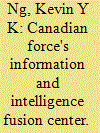

|
|
|
|
|
| Publication |
2009.
|
| Summary/Abstract |
To operate effectively in the twenty first century, the Canadian forces (CF) will require a broad range of capabilities in order to plan, execute ans sustain both domestic and deployed tactical and strategic operations. However, at the heart of all successful execution of these mission is the requirement for military decision-makers at all levels to have access to information and interlligence that is eqally time-sensitive and situation relevant.
|
|
|
|
|
|
|
|
|
|
|
|
|
|
|
|
| 2 |
ID:
108293
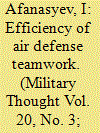

|
|
|
| 3 |
ID:
091124
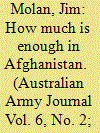

|
|
|
|
|
| Publication |
2009.
|
| Summary/Abstract |
The fight against the Taliban in Afghanistan has lasted for almost eight years now-longer than even the Second World War. The author argues that in this time, progress has been made, but that it has been made against a tide that now threatens to wash away the modest gains so bitterly made. Australian forces have been making gains in their sector, but with the Dutch contingent expected to leave sooner rather than later, the author insists that only a significantly increased Australian presence will help maintain the momentum towards success now slowly building. A surge now will give local Afghan forces the necessary breathing space within which they can be trained. If this training is conducted intelligently
and thoroughly, Afghan forces may reach a standard during this time such that Australian leaders could then seriously consider handing over responsibility for security. Ultimately, this could mean success, and a real chance to 'bring the diggers back home'.
|
|
|
|
|
|
|
|
|
|
|
|
|
|
|
|
| 4 |
ID:
137892


|
|
|
|
|
| Summary/Abstract |
The Line of Control (LC), as known, is crucial for India’s security and any violation can lead to serious consequences. Last year, for instance, maximum incidents of ceasefire violation took place here, and analysts expect the trend to continue this year too. What with the US expeditionary troops leaving Afghanistan, there are chances of serious infiltration by terrorists along the Indo-Pak border. In such a scenario, it becomes extremely crucial for the Indian Army to maintain its night fighting capabilities at the LC. Also, it must beef up the day and night surveillance capabilities at the border.
|
|
|
|
|
|
|
|
|
|
|
|
|
|
|
|
| 5 |
ID:
098957
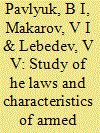

|
|
|
| 6 |
ID:
091127
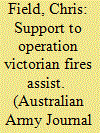

|
|
|
|
|
| Publication |
2009.
|
| Summary/Abstract |
The Victorian bush fires of February 2009 swiftly destroyed nearly two thousand homes and took over 170 lives. Yet, equally as swift, and in spite of the extensive damage, the ADF responded quickly and efficiently to this disaster with Operation VICTORIAN FIRES ASSIST. While the success of this operation was obvious for all to see, the author identifies several lessons that can be drawn from this unique experience, examining what worked as well as what did not-and how matters could be improved. To this end, the author offers a number of practical and innovative suggestions for how the ADF can better utilise its mix of contractor and military provided base services to better support ongoing warfighting tasks while mounting an equally effective response to similar contingencies in future.
|
|
|
|
|
|
|
|
|
|
|
|
|
|
|
|